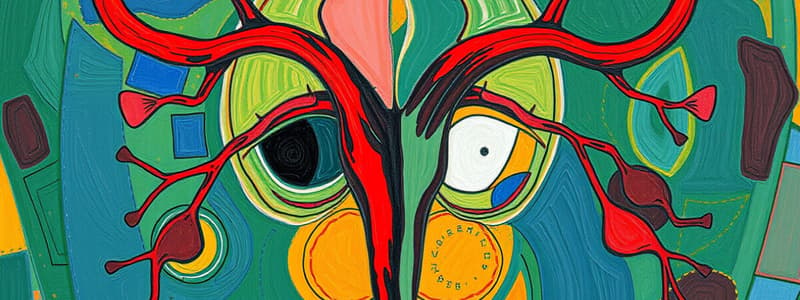Podcast
Questions and Answers
Where is the pituitary gland (hypophysis) located?
Where is the pituitary gland (hypophysis) located?
- Within the hypothalamus
- Above the cerebellum
- In the sella turcica of the sphenoid bone (correct)
- In the medulla oblongata
What type of glands are the parotid glands?
What type of glands are the parotid glands?
Serous glands
What determines whether giantism or acromegaly will occur due to oversecretion of growth hormone?
What determines whether giantism or acromegaly will occur due to oversecretion of growth hormone?
Whether the epiphyses of the long bones have fused with the shaft.
What do the anterior lobe of the pituitary gland's lactotropes secrete?
What do the anterior lobe of the pituitary gland's lactotropes secrete?
What is the proper sequence of the adrenal cortex zones from the inside out?
What is the proper sequence of the adrenal cortex zones from the inside out?
What does the adrenal cortex produce?
What does the adrenal cortex produce?
What is an exocrine gland?
What is an exocrine gland?
What is a characteristic of merocrine exocrine glands?
What is a characteristic of merocrine exocrine glands?
What do apocrine exocrine glands discharge?
What do apocrine exocrine glands discharge?
What is the function of holocrine exocrine glands?
What is the function of holocrine exocrine glands?
What do endocrine glands secrete?
What do endocrine glands secrete?
Flashcards are hidden until you start studying
Study Notes
Sella Turcica
- The sella turcica is a small, pea-shaped depression in the sphenoid bone.
- It houses the pituitary gland (hypophysis), located on the brain's inferior surface.
Parotid Glands
- Composed entirely of serous tissue, characterized by serous acini.
- Contains abundant rough endoplasmic reticulum (rER), free ribosomes, a prominent Golgi complex, and numerous secretory granules.
Growth Hormone Disorders
- The occurrence of giantism or acromegaly is determined by whether the epiphyses of the long bones have fused with the shaft.
Pituitary Gland Lobes
- The posterior lobe consists of unmyelinated nerve fibers and secretes antidiuretic hormone (ADH) and oxytocin.
- The anterior lobe contains alpha cells (somatotropes and lactotropes) and beta cells (corticotropes, gonadotropes, and thyrotropes).
- Corticotropes produce ACTH, which stimulates cortisol production, aiding metabolism and stress management.
- Gonadotropes secrete FSH and LH, while thyrotropes secrete thyroid-stimulating hormone (TSH).
Adrenal Cortex Zones
- Zones of the adrenal cortex from inner to outer: zona reticularis, zona fasciculata, and zona glomerulosa.
- Zona reticularis secretes small amounts of cortisol and DHEA.
- Zona fasciculata primarily secretes glucocorticoids, especially cortisol.
- Zona glomerulosa secretes mineralocorticoids, primarily aldosterone, which regulates electrolyte and water balance.
Adrenal Glands
- The adrenal glands are flattened, triangular endocrine glands located atop each kidney.
- The adrenal cortex generates steroid hormones (mineralocorticoids, glucocorticoids, and sex hormones).
- The adrenal medulla, derived from neuroectoderm, produces epinephrine and norepinephrine.
- The adrenal medulla is non-essential for life, while the cortex arises from mesoderm.
Exocrine Glands
- Exocrine glands possess ducts through which substances like sweat, saliva, and digestive enzymes are released.
- Examples include sebaceous glands, which are associated with hair follicles and derived from ectoderm.
Merocrine Exocrine Glands
- These glands release products by secreting water, crucial for temperature regulation and digestion.
- Examples include salivary glands, pancreatic glands, and certain sweat glands.
Apocrine Exocrine Glands
- Apocrine glands discharge a portion of their secretory cells along with their secretion.
- They provide nourishment to infants and assist in temperature regulation, like mammary and certain sweat glands.
Holocrine Exocrine Glands
- Holocrine glands release entire secretory cells along with their enclosed secretion.
- Sebaceous glands of the skin condition the skin through their secretion.
Endocrine Glands
- Endocrine glands secrete hormones into interstitial fluid surrounding secretory cells.
- Hormones diffuse into capillaries and are transported by blood throughout the body.
Studying That Suits You
Use AI to generate personalized quizzes and flashcards to suit your learning preferences.




